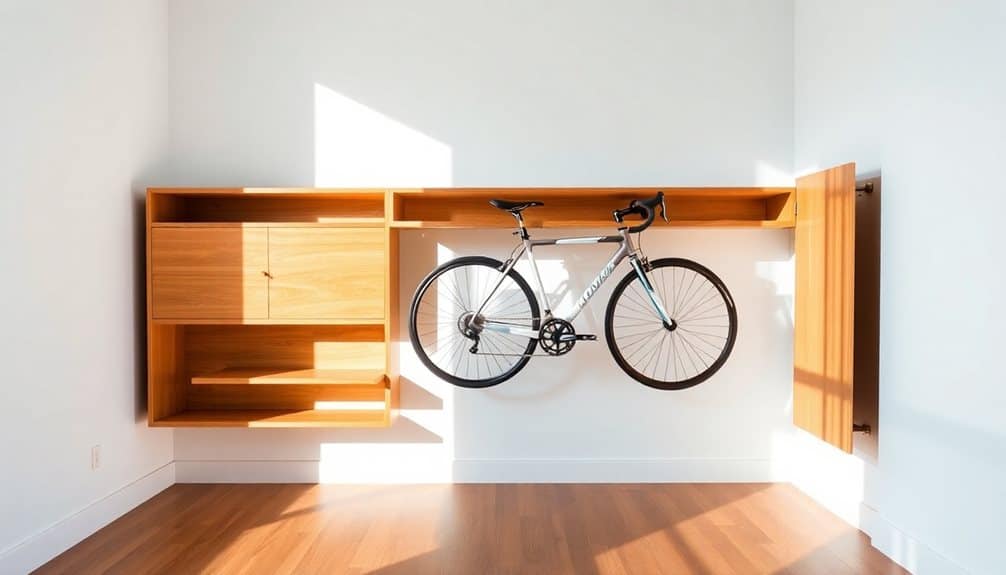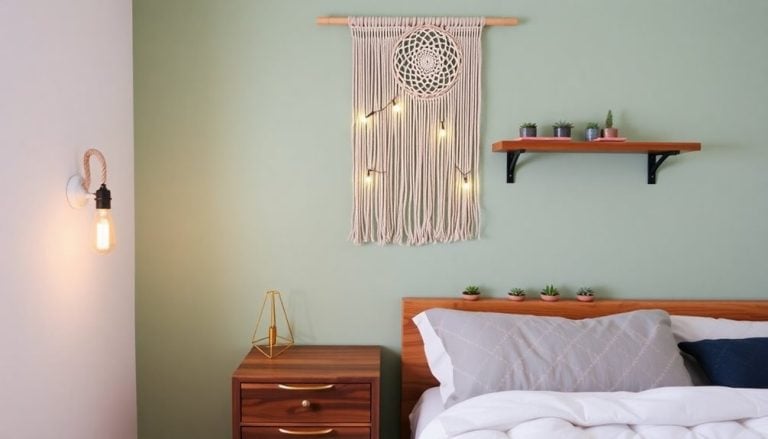This website contains affiliate links. Some products are gifted by the brand to test. As an Amazon Associate, I earn from qualifying purchases. The content on this website was created with the help of AI.
Transform your compact living space with smart DIY projects that maximize every inch. You’ll find endless possibilities with floating shelves featuring hidden compartments, space-saving room dividers that double as storage, and vertical gardens that bring nature indoors. Under-bed rolling drawers and fold-down desks offer clever solutions for dual-purpose functionality, while wall-mounted kitchen organizers keep essentials within reach. A Murphy bed installation or multi-purpose ottoman can instantly switch your room’s function. With these innovative storage solutions and design techniques, you’ll discover how your small space holds unlimited potential for stylish, efficient living.
Key Takeaways
- Install floating shelves with hidden compartments to maximize vertical wall space while providing discreet storage for valuables.
- Create custom under-bed rolling drawers with clear acrylic tops for easy visibility and organized storage of seasonal items.
- Build a fold-down desk with built-in storage compartments and reliable locking mechanisms for a space-efficient home office.
- Convert an ottoman into multi-purpose furniture using a wooden box frame, adding storage, seating, and table functionality.
- Set up modular room dividers with integrated storage boxes to create separate functional zones without permanent construction.
Floating Shelves and Hidden Storage
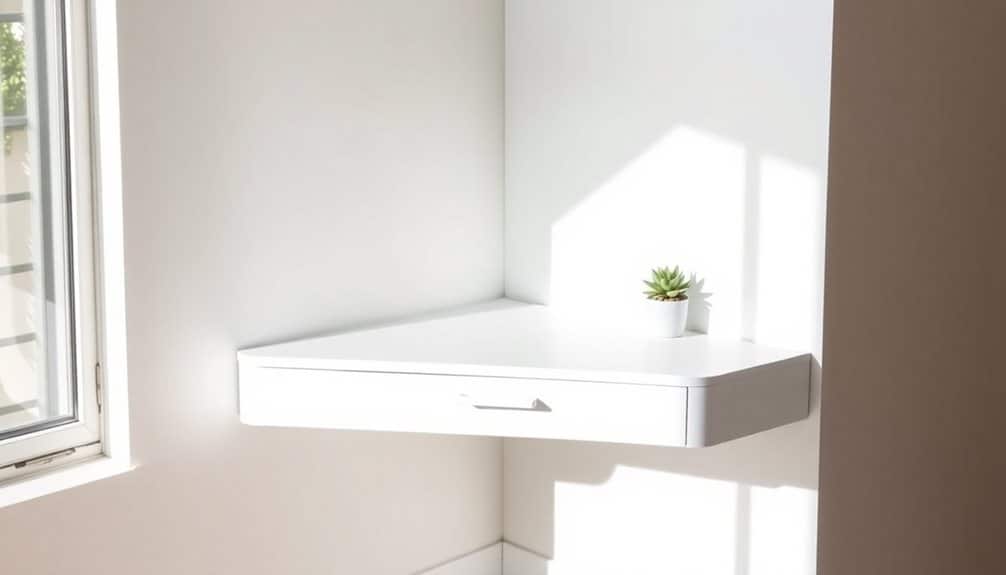
Floating shelves effortlessly combine form and function, making them ideal storage solutions for compact living spaces. By mounting these sleek platforms directly onto your walls, you’ll create valuable storage without sacrificing precious floor space. Choose slim-profile brackets that disappear behind the shelves for a clean, minimalist look that won’t overwhelm your room’s visual flow.
Take your storage game further by incorporating hidden compartments within your floating shelves. Install a hinged shelf front that opens to reveal a concealed storage space perfect for valuables or rarely-used items. You can also design corner floating shelves with secret pull-out sections, maximizing typically unused spaces while maintaining a streamlined appearance.
For maximum impact, arrange your floating shelves in geometric patterns or asymmetrical compositions that double as wall art. Consider installing LED strip lighting underneath to create ambient lighting and highlight displayed items. Select materials that complement your existing décor – whether it’s warm wood tones, industrial metal finishes, or modern acrylic. Remember to anchor your shelves properly into wall studs or use appropriate wall anchors to guarantee they can safely support your stored items.
Quality bamboo shelving offers superior water resistance while adding natural warmth to your space.
Space-Saving Room Dividers
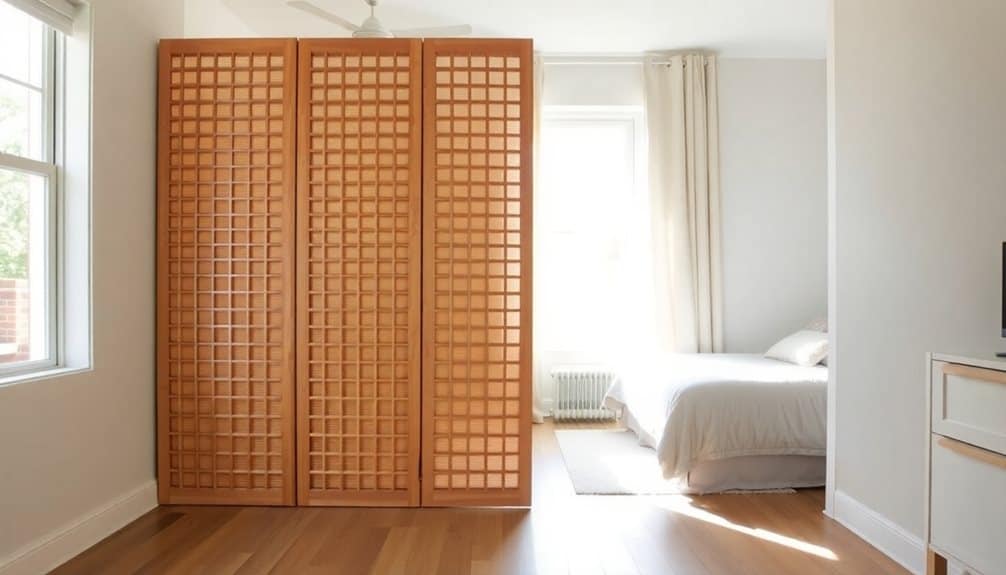
While wall-mounted storage solutions maximize vertical space, room dividers can transform a single room into distinct functional zones without permanent construction. You’ll find that strategic dividers serve dual purposes: they create privacy and add storage opportunities while maintaining an open feel. By choosing materials like reclaimed wood, frosted acrylic, or industrial pipe, you can craft dividers that complement your existing décor while defining separate areas for working, sleeping, or dining.
Consider building modular dividers that you can easily reconfigure as your needs change. Opt for designs incorporating shelving, hanging racks, or fold-out surfaces to maximize functionality. The key is creating a balance between separation and openness, ensuring natural light still flows through your space.
- Sliding panels mounted on ceiling tracks with built-in storage pockets for a sleek, minimalist look
- Geometric lattice screens crafted from wooden dowels, perfect for hanging plants or displaying artwork
- Rolling bookshelf dividers with adjustable compartments and swivel casters
- Hanging macramé or rope dividers with integrated planter boxes for a bohemian touch
These DIY room dividers not only define your space but also add character and storage solutions to your small living area. Incorporating stylish storage boxes into your room divider design helps keep your space organized while maintaining a cohesive aesthetic.
Vertical Garden Solutions
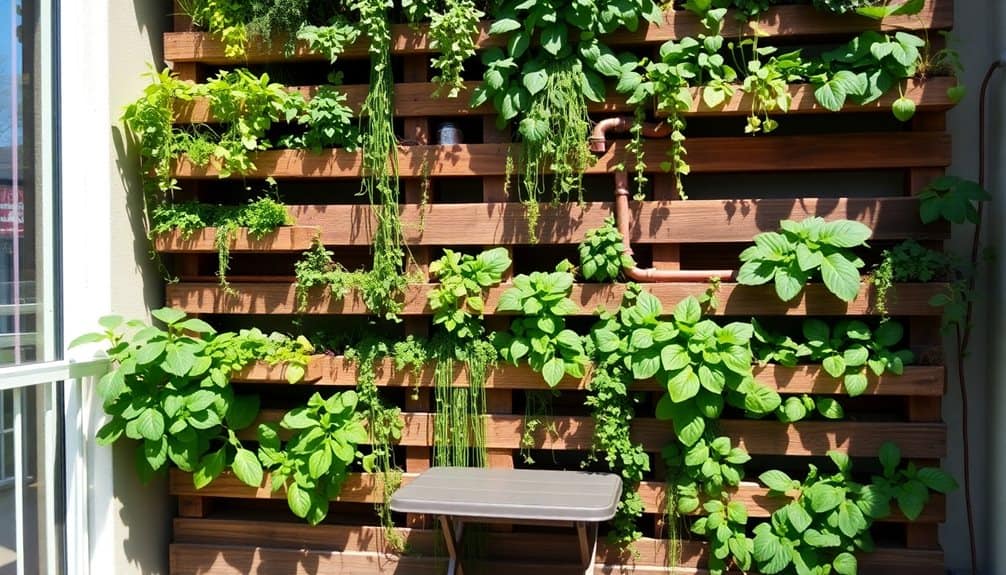
Since floor space comes at a premium in compact homes, vertical gardens offer an elegant solution for bringing nature indoors without sacrificing valuable square footage. You’ll find that mounting plants on walls transforms unused vertical surfaces into living, breathing artwork while maximizing your limited space.
Start by selecting a sturdy mounting system that suits your walls. You can create a modular design using repurposed wooden pallets, install pocket planters, or mount floating shelves specifically designed for potted plants. For rental-friendly options, take into account using tension rods with hanging planters or installing removable grid systems.
Choose plants that thrive in vertical conditions and match your light exposure. Succulents, air plants, and trailing vines like pothos or ivy work exceptionally well. You’ll want to incorporate a reliable irrigation system – try installing a drip system with a collection tray or opt for self-watering planters to minimize maintenance and protect your walls.
Don’t forget to take into account weight distribution and waterproofing. Install a moisture barrier between your garden and the wall, and make sure your mounting hardware can support both the planters and saturated soil weight. Consider using shelving units with powder-coated steel construction for maximum durability against moisture and rust in your vertical garden setup.
Under-Bed Rolling Drawers
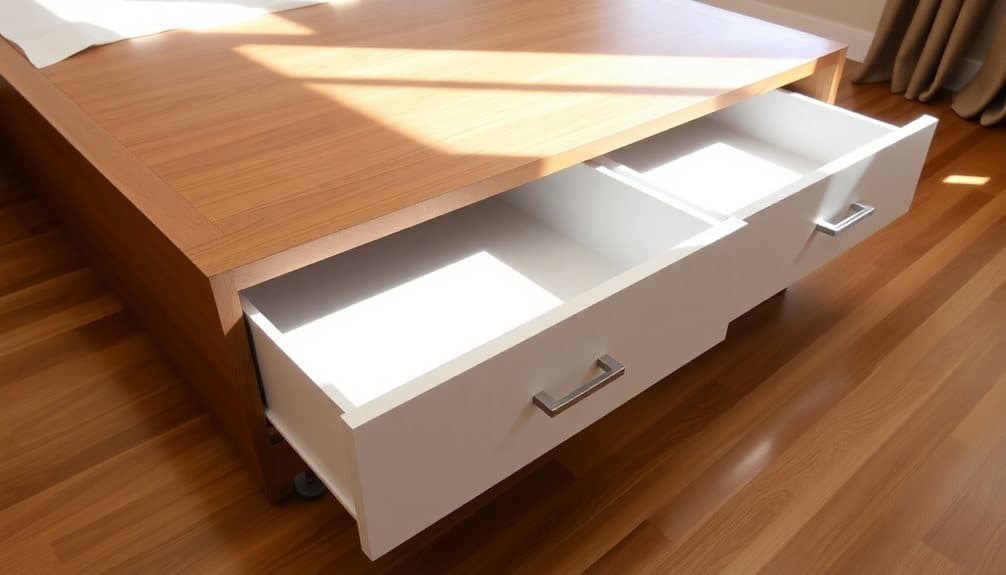
Moving from walls to floors, the space beneath your bed represents prime real estate for storage solutions. By creating custom rolling drawers, you’ll transform this often-neglected area into organized, accessible storage that maximizes every square inch. The key to successful under-bed storage lies in designing drawers that glide smoothly while protecting your items from dust.
Select sturdy casters that can handle frequent use and match your flooring type. Opt for durable materials like plywood or medium-density fiberboard (MDF) to construct drawers that won’t warp under weight. Adding handles and stops guarantees easy maneuvering and prevents drawers from rolling too far.
- Build shallow drawers for storing seasonal clothing, bedding, and accessories
- Install dividers to organize smaller items like shoes, bags, and accessories
- Add cedar panels to protect stored clothing from moths and moisture
- Consider clear acrylic tops to easily identify contents without pulling drawers out
Measure your space carefully, accounting for baseboards and bed frame clearance. Paint or stain your drawers to complement your bedroom’s aesthetic, or cover them with wallpaper for added visual interest. Remember to leave enough space between drawers for smooth operation. For maximum durability and protection against cracking, choose drawers made from high-quality polypropylene materials that can withstand daily use.
Fold-Down Desk and Tables
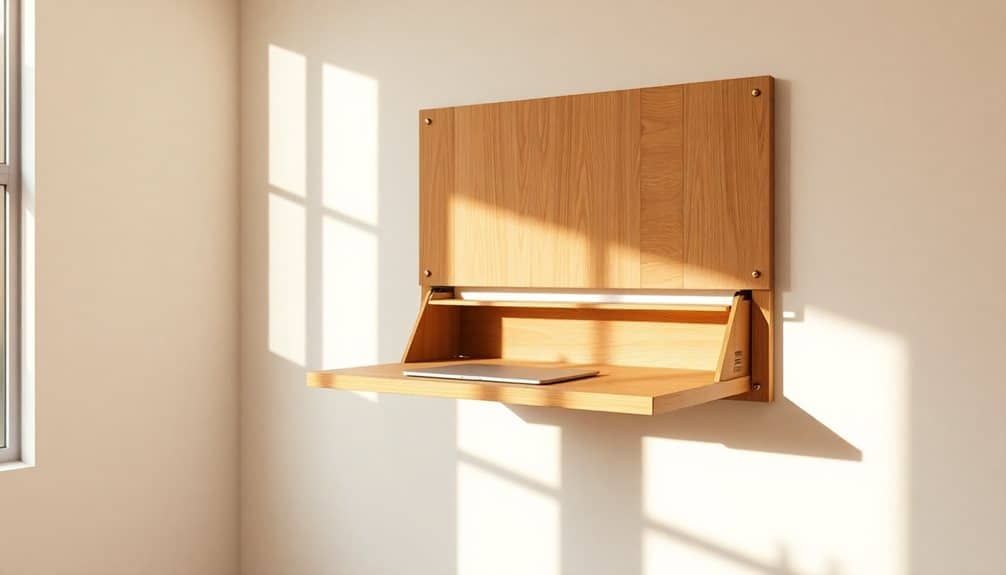
In accordance with modern space-saving design, fold-down desks and tables offer an ingenious solution for creating functional work surfaces without sacrificing precious floor space. When mounted on a wall, these convertible pieces seamlessly shift between active use and discreet storage, making them perfect for compact living environments.
To maximize vertical organization, consider installing wall-mounted hooks above your fold-down workspace for hanging bags and supplies.
You’ll want to select a sturdy wall-mounting system that can support both the weight of the desk and your work materials. Consider incorporating a built-in storage compartment within the fold-down surface to house your office supplies or dining essentials. For peak functionality, install your fold-down piece at standard desk height (29-30 inches) or dining table height (28-30 inches), depending on its primary purpose.
To enhance the aesthetic appeal, choose materials that complement your existing décor. Popular options include solid wood for warmth, sleek laminates for durability, or industrial metal for a contemporary look. You can further customize your piece by adding features like cable management systems, LED lighting, or a magnetic board when folded up. Remember to include a reliable locking mechanism to guarantee stability during use and secure closure when stored.
Wall-Mounted Kitchen Organization
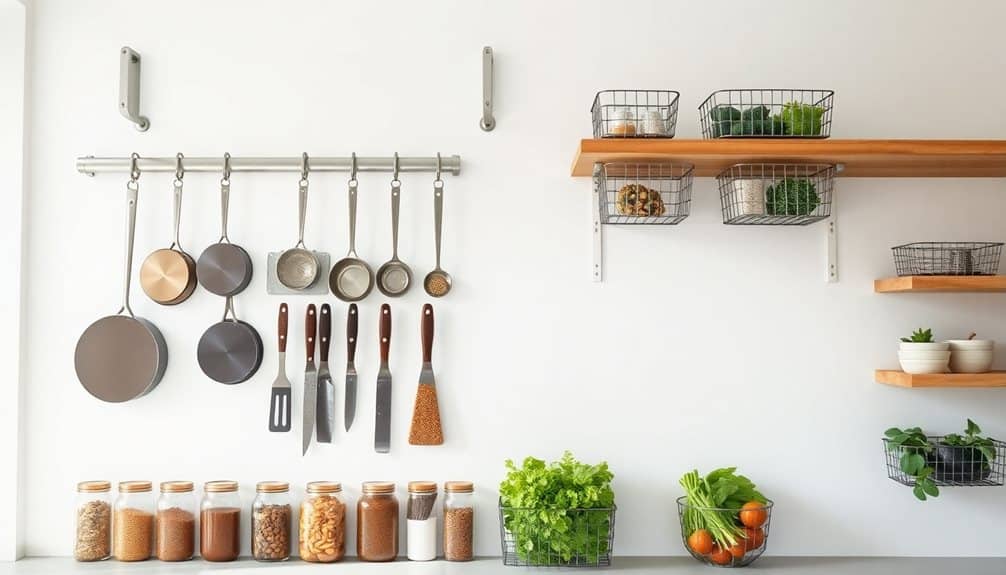
The vertical domain of kitchen walls presents untapped potential for innovative storage solutions that can transform cluttered countertops into organized workspaces. You’ll discover that mounting storage systems vertically not only maximizes your kitchen’s footprint but also creates an efficient workflow that professional chefs swear by.
Consider installing a combination of magnetic strips, pegboards, and floating shelves to establish a cohesive organizational system. You can customize these elements to match your kitchen’s aesthetic while maintaining functionality. A well-planned wall system keeps your essential tools within arm’s reach and turns your kitchen items into an artistic display.
- Create a magnetic knife strip using reclaimed wood and strong magnets, adding both rustic charm and practicality
- Install a pegboard with movable hooks and small shelves for frequently used utensils and spice jars
- Mount a series of tension rods between cabinets for hanging cleaning supplies and paper towels
- Design a modular floating shelf system with integrated mason jar storage for dry goods and cooking ingredients
When planning your wall-mounted organization, focus on grouping items by function and frequency of use while maintaining clean lines and visual balance throughout the space.
Murphy Bed Installation
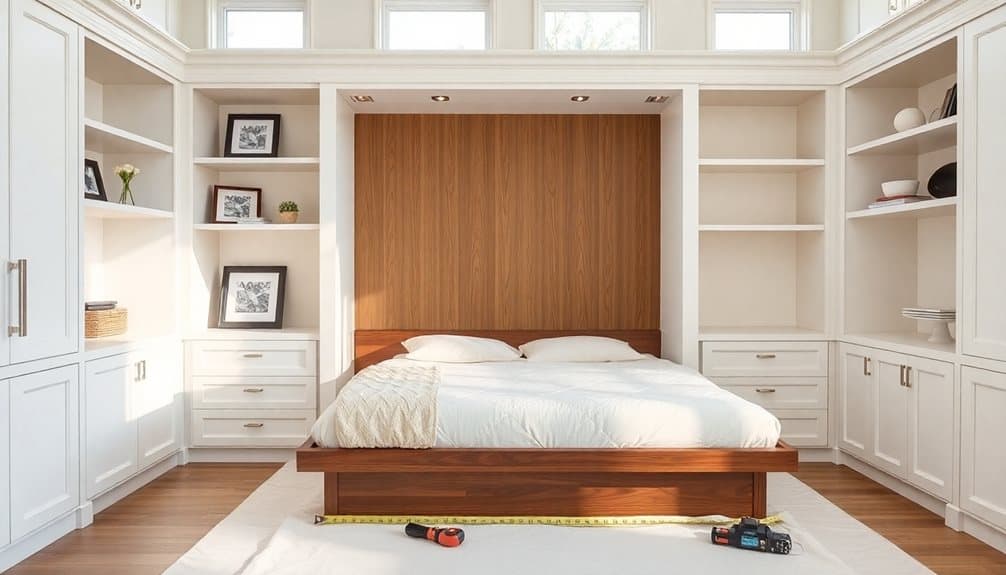
Every square foot counts when maximizing a small living space, making Murphy beds an elegant solution for dual-purpose rooms. Installing a Murphy bed transforms your space from bedroom to living area in minutes, and with proper planning, you’ll create a seamless integration that looks built-in rather than aftermarket.
Start by selecting a wall-mounting kit that matches your room’s dimensions and weight requirements. You’ll need at least 82 inches of vertical clearance and sufficient wall support – locate your studs and reinforce the mounting area if necessary. Choose between vertical or horizontal orientation based on your ceiling height and available wall space.
Consider incorporating additional storage elements like side cabinets or shelving into your Murphy bed design. Built-in LED lighting and USB charging ports can enhance functionality, while crown molding and trimwork help the unit blend with existing architectural details. When selecting your finish, match it to your room’s color scheme and consider using panels that complement your existing furniture.
Remember to factor in clearance space for furniture placement when the bed’s folded down, and install safety mechanisms to prevent accidental closure.
Closet Maximizing Systems
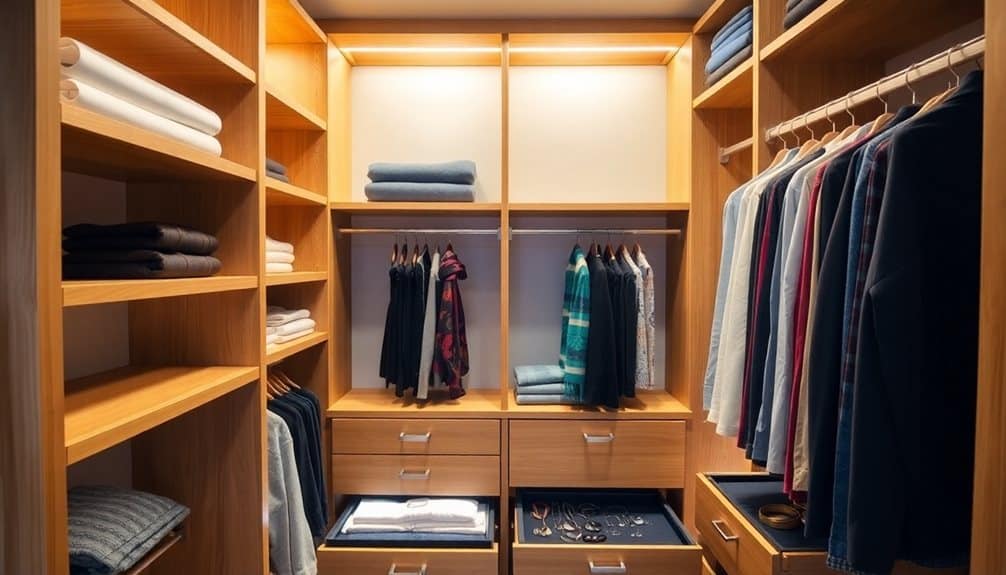
Smart closet organization complements other space-saving solutions like Murphy beds, transforming even the most compact storage areas into efficient, stylish havens. You’ll maximize every inch of vertical space by installing adjustable shelving systems that can evolve with your storage needs. Custom-cut closet rods at varying heights let you double or triple your hanging capacity, while modern slide-out organizers keep accessories and smaller items perfectly sorted.
Consider these essential components for your DIY closet system:
- Multi-level hanging rods with chrome or brushed nickel finishes that add both function and sophistication
- Pull-out baskets and drawers that utilize formerly wasted corner spaces
- Over-the-door organizers with clear acrylic pockets for shoes and accessories
- Modular cube storage with removable fabric bins for seasonal rotation
When designing your system, focus on creating zones for different categories of items. Install LED strip lighting under shelves to illuminate dark corners, and use slim velvet hangers to reduce bulk. Incorporate pull-down rods for high storage areas, making upper spaces accessible without a step stool. Remember to leave breathing room between items to maintain visual order and easy access.
Multi-Purpose Ottoman Projects
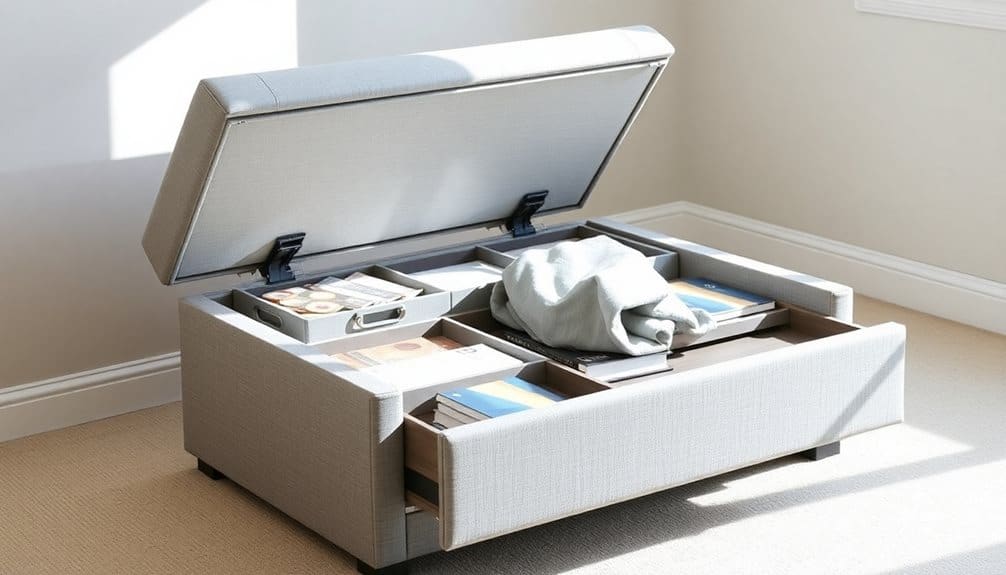
Looking for furniture that works twice as hard in your small space? A DIY multi-purpose ottoman can serve as seating, storage, and even an impromptu coffee table. With basic tools and materials, you’ll create a versatile piece that maximizes every square inch of your room.
Start with a wooden box frame or repurpose an old trunk as your base. Add heavy-duty casters for mobility, ensuring they can support both the ottoman’s weight and its contents. Layer high-density foam on top, wrapping it in batting for a professional finish. Select a durable upholstery fabric that complements your decor – think stain-resistant materials like Sunbrella or performance velvet.
Inside, install dividers to organize everything from spare blankets to board games. Consider adding a hinged lid with soft-close hardware to prevent slamming. For extra functionality, create a reversible top: upholstered on one side and a solid surface on the other for a stable table option. Add a slim tray that fits neatly inside but can be removed when you need a flat surface for drinks or laptops. Paint or stain any exposed wood to match your existing furniture.
Frequently Asked Questions
Can I Make DIY Smart Storage Solutions in a Rental Without Damaging Walls?
You’ll find plenty of rental-friendly storage solutions that don’t require wall mounting. Try freestanding modular cube organizers, tension rod systems between floors and ceilings, or over-the-door organizers for instant vertical storage. Use command hooks for lightweight items, and invest in furniture with built-in storage like ottoman beds or nesting tables. Rolling carts create flexible organization you can easily move around.
What Tools and Skill Level Are Needed for These Small-Space Projects?
Did you know 78% of DIY beginners succeed with just a basic toolset? You’ll need essential tools like a screwdriver set, measuring tape, level, and cordless drill. Most small-space storage projects require entry-level skills – if you can follow instructions and measure accurately, you’re set. For more advanced projects, you might want a saw and power drill, but you’ll develop these skills naturally as you tackle simpler projects first.
How Much Money Should I Budget for a Complete Small-Space Makeover?
You’ll need to budget between $500-2,000 for an extensive small-space makeover, depending on your design choices. Plan to allocate 40% for storage solutions, 30% for multipurpose furniture pieces, 20% for lighting and hardware, and 10% for decorative elements. If you’re working with higher-end materials or custom pieces, your budget might stretch to $3,000+. Don’t forget to factor in shipping costs and tools.
Which DIY Projects Add the Most Resale Value to a Small Home?
Like polishing a diamond, your small home’s value can shine brighter with strategic DIY upgrades. You’ll get the best return by updating your kitchen with new cabinet hardware, modern backsplash tiles, and pendant lighting. Fresh paint throughout, upgraded bathroom fixtures, and built-in storage solutions also boost value greatly. Don’t forget curb appeal – a well-designed entry area and window boxes can instantly attract buyers.
Are Permits Required for Structural Changes in Small-Space DIY Renovations?
You’ll need permits for most structural changes, regardless of your space’s size. This includes removing walls, modifying load-bearing elements, changing roof structures, or altering floor joists. Contact your local building department before starting any structural work – even seemingly minor changes could require official approval. Skipping permits can lead to costly fixes, failed home inspections, and safety issues during resale.

